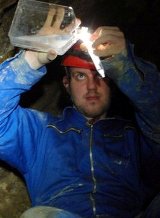Rich Boden
Microbial food webs in Movile Cave
Due to technical limitations, this website will not be updated (from March 2011). Please refer to my personal webpages instead: www.richboden.com
Movile Cave (Peştera Movile) is a cave located in Constanţa County, Romania, close to the Black Sea. The Cave is unusual in many ways, not least because, prior to its discovery in 1986, it had no natural entrance and was sealed from the outside world. The atmosphere inside the cave is unusual in that it contains a third to half of the oxygen concentration found in air (7-10% O2 in the Cave atmosphere, versus 21% O2 in air) and around one hundred times the carbon dioxide concentration found in air (2-3.5% CO2 in the Cave atmosphere, versus 0.03% CO2 in air). The atmosphere of the Cave also contains 1-2% methane (CH4) and the atmosphere and waters of the Cave contain high concentrations of hydrogen sulfide (H2S) and ammonia (NH3) - both gases that are toxic to many living organisms, including humans. Nonetheless, Movile Cave is home to a range of living organisms (many of which are unique to the Cave) ranging from micro-organisms such as Bacteria and Archaea up to leeches, water-spiders, scorpians and insects.
Throughout the planet, many organisms (such as Bacteria and plants) use carbon dioxide from the air or water into produce organic compounds (such as sugars) in a process called primary production. In most cases, primary production occurs through photosynthesis and is therefore dependent upon light. Since Movile Cave is a dark environment into which natural light does not penetrate, primary production in this environment instead occurs through chemosynthesis - the chemically-driven fixation of carbon dioxide into organic matter. Chemosynthesis is primarily achieved by micro-organisms - the Bacteria and Archaea and occurs when simple reduced inorganic compounds (for example, hydrogen sulfide) are oxidised (for example, into sulfuric acid) with the electrons being transfered to the organism's respiratory chain.
Our research at Warwick concerns chemosynthetic organisms in Movile Cave which derive their energy from a range of inorganic compounds such as ammonia (NH3), hydrogen sulfide (H2S), thiosulfate (S2O32-), polythionates (SnO62-, n = 3-150) and elemental sulfur (S0). We are also interested in the production of methane (CH4) by Archaea present in the Cave and the subsequent consumption of methane by methanotrophic Bacteria, along with the closely-related metabolic processes (methylotrophy) for the consumption of small organic compounds such as methanol (CH3OH), formic acid (CH3OOH), formaldehyde (HCHO) and methylated nitrogen and sulfur compounds, such as monomethylamine (CH3NH2) and dimethylsulfide ((CH3)2S).
You can find more information about the Movile Cave project and about my work at my personal website - www.richboden.com
Supervision & Funding
Supervisor: Professor J Colin Murrell
Funding: Natural Environmental Research Council (UK)
Collaborators
Dr Alexandra-Maria Hillebrand, Emil Racoviţă Institute for Speleology (Romania)
Grupul de Explorari Subacvatice si Speologice (Group for Underwater and Cave Exploration), Romania
Movile Cave, Romania
Movile Cave is located just outside of the city of Mangalia in southern Romania, close to the Black Sea. The Cave is located beneath the circular depression (obanul mare, the high sinkhole; also known locally as obanul de la movile, the sinkhole of the mounds) at the centre of the map which is surrounded by the small mounds (movile - mounds) that give the Cave its name.

Rich Boden
Rich dot Boden at warwick dot ac dot uk
